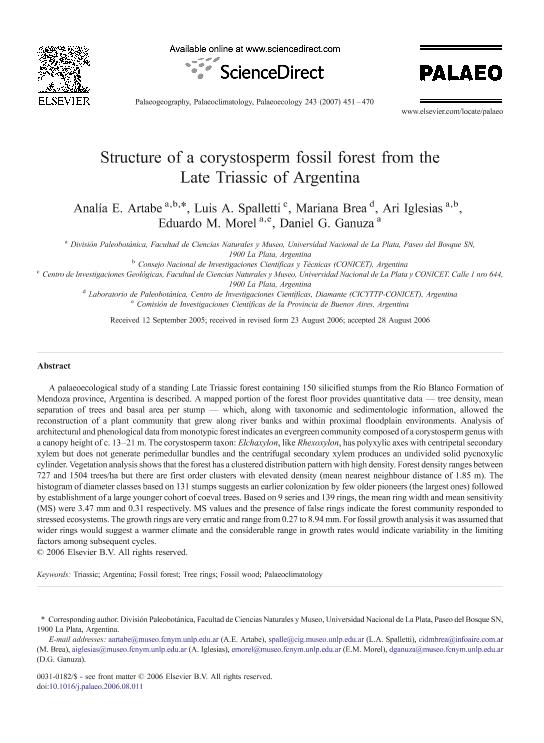Artículo
Structure of a corystosperm fossil forest from the Late Triassic of Argentina
Artabe, Analia Emilia Eva ; Spalletti, Luis Antonio
; Spalletti, Luis Antonio ; Brea, Mariana
; Brea, Mariana ; Iglesias, Ari
; Iglesias, Ari ; Morel, Eduardo Manuel; Ganuza, Daniel Gustavo
; Morel, Eduardo Manuel; Ganuza, Daniel Gustavo
 ; Spalletti, Luis Antonio
; Spalletti, Luis Antonio ; Brea, Mariana
; Brea, Mariana ; Iglesias, Ari
; Iglesias, Ari ; Morel, Eduardo Manuel; Ganuza, Daniel Gustavo
; Morel, Eduardo Manuel; Ganuza, Daniel Gustavo
Fecha de publicación:
01/2007
Editorial:
Elsevier Science
Revista:
Palaeogeography, Palaeoclimatology, Palaeoecology
ISSN:
0031-0182
Idioma:
Inglés
Tipo de recurso:
Artículo publicado
Clasificación temática:
Resumen
A palaeoecological study of a standing Late Triassic forest containing 150 silicified stumps from the Río Blanco Formation of Mendoza province, Argentina is described. A mapped portion of the forest floor provides quantitative data - tree density, mean separation of trees and basal area per stump - which, along with taxonomic and sedimentologic information, allowed the reconstruction of a plant community that grew along river banks and within proximal floodplain environments. Analysis of architectural and phenological data from monotypic forest indicates an evergreen community composed of a corystosperm genus with a canopy height of c. 13-21 m. The corystosperm taxon: Elchaxylon, like Rhexoxylon, has polyxylic axes with centripetal secondary xylem but does not generate perimedullar bundles and the centrifugal secondary xylem produces an undivided solid pycnoxylic cylinder. Vegetation analysis shows that the forest has a clustered distribution pattern with high density. Forest density ranges between 727 and 1504 trees/ha but there are first order clusters with elevated density (mean nearest neighbour distance of 1.85 m). The histogram of diameter classes based on 131 stumps suggests an earlier colonization by few older pioneers (the largest ones) followed by establishment of a large younger cohort of coeval trees. Based on 9 series and 139 rings, the mean ring width and mean sensitivity (MS) were 3.47 mm and 0.31 respectively. MS values and the presence of false rings indicate the forest community responded to stressed ecosystems. The growth rings are very erratic and range from 0.27 to 8.94 mm. For fossil growth analysis it was assumed that wider rings would suggest a warmer climate and the considerable range in growth rates would indicate variability in the limiting factors among subsequent cycles. © 2006 Elsevier B.V. All rights reserved.
Palabras clave:
Argentina
,
Fossil Forest
,
Fossil Wood
,
Palaeoclimatology
,
Tree Rings
,
Triassic
Archivos asociados
Licencia
Identificadores
Colecciones
Articulos(CCT - LA PLATA)
Articulos de CTRO.CIENTIFICO TECNOL.CONICET - LA PLATA
Articulos de CTRO.CIENTIFICO TECNOL.CONICET - LA PLATA
Articulos(CICYTTP)
Articulos de CENTRO DE INV.CIENT.Y TRANSFERENCIA TEC A LA PROD
Articulos de CENTRO DE INV.CIENT.Y TRANSFERENCIA TEC A LA PROD
Articulos(CIG)
Articulos de CENTRO DE INVEST.GEOLOGICAS (I)
Articulos de CENTRO DE INVEST.GEOLOGICAS (I)
Citación
Artabe, Analia Emilia Eva; Spalletti, Luis Antonio; Brea, Mariana; Iglesias, Ari; Morel, Eduardo Manuel; et al.; Structure of a corystosperm fossil forest from the Late Triassic of Argentina; Elsevier Science; Palaeogeography, Palaeoclimatology, Palaeoecology; 243; 3-4; 1-2007; 451-470
Compartir
Altmétricas



